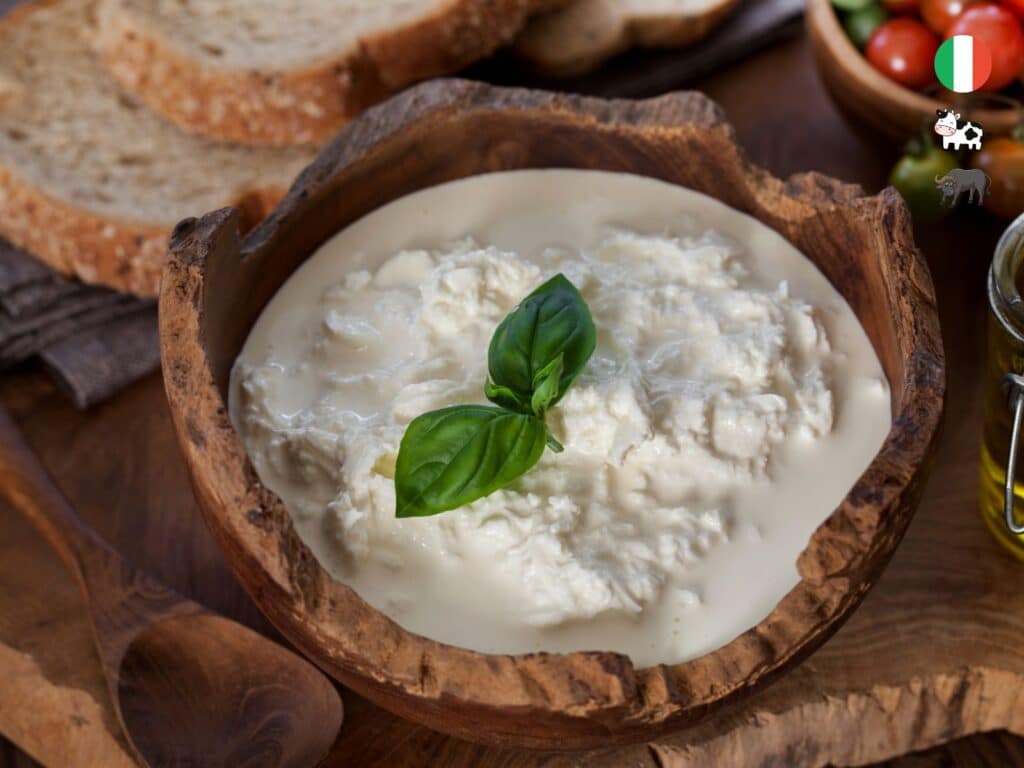When we think of Italian cheese, names like Parmigiano Reggiano, Mozzarella and Gorgonzola often come to mind. However, nestled among these celebrated varieties is a lesser-known gem: Stracciatella. This delightful cheese, with its creamy texture and rich flavour, deserves a moment in the spotlight. Let’s dive into the origins, production, culinary uses, and the sheer joy of enjoying Stracciatella.

What is Stracciatella?
Stracciatella is a fresh Italian pasta filata cheese that originates from the region of Puglia, located in the southeastern part of Italy. It is most commonly associated with the preparation of Burrata, where the creamy filling is made. The name “stracciatella” translates to “little rags,” a reference to the way the cheese is made by shredding Mozzarella curds into thin strands that are then mixed with fresh cream.
The cheese is characterized by its smooth, creamy texture and a mild, slightly tangy flavour profile. Unlike many aged cheeses, Stracciatella is meant to be enjoyed fresh, making it a perfect addition to various dishes or as a standalone treat.
The Production Process
The process of making Stracciatella is both art and science. It begins with the traditional methods of cheesemaking, starting with high-quality milk, usually from water buffalo or cows. After the milk is warmed and curdled, the curds are cut and stirred.
Once the curds have reached the desired consistency, they are drained and then cut into small pieces. These pieces are then shredded—hence the name “stracciatella”—and mixed with rich, fresh cream. The result is a luscious, spreadable cheese that captures the essence of its ingredients.
The beauty of Stracciatella lies in its freshness. It’s best consumed shortly after production, which is why artisanal producers often make small batches that are sold locally.
Culinary Uses of Stracciatella
Stracciatella’s versatility makes it a favourite among chefs and home cooks alike. Here are several ways to enjoy this creamy delight:
1. On Bread and Crackers
One of the simplest and most enjoyable ways to savour Stracciatella is to spread it on fresh bread or crackers. The creamy texture complements the crunch of toasted bread perfectly. For an elevated touch, drizzle with high-quality olive oil, sprinkle with sea salt, or add a hint of freshly cracked pepper.
2. As a Pasta Sauce
Stracciatella can also be used as a creamy pasta sauce. After cooking your pasta of choice, toss it with a generous scoop of Stracciatella and a splash of pasta cooking water. This creates a luscious, rich sauce that clings beautifully to the pasta. Add fresh herbs like basil or parsley for an aromatic finish.
3. In Salads
Add Stracciatella to salads for a creamy contrast. It pairs wonderfully with roasted vegetables, tomatoes or fresh greens. A simple dressing of balsamic vinegar and olive oil allows the cheese to shine, bringing a new level of indulgence to your salad.
4. On Pizza
For a twist on traditional pizza, dollop Stracciatella on top before serving. Its creaminess adds a rich layer of flavour that elevates any pizza, especially those topped with fresh vegetables or prosciutto.
5. As a Filling
Stracciatella makes an excellent filling for stuffed pasta, such as ravioli or tortellini. Mixing it with ingredients like spinach, herbs, or even a bit of truffle oil can create a deliciously decadent dish that is sure to impress.
Pairing Stracciatella
When it comes to pairing Stracciatella with beverages, the possibilities are abundant. A crisp white wine, such as a Pinot Grigio or a Verdicchio, complements the creamy texture beautifully. If you prefer red wine, a light-bodied Chianti or a Beaujolais can offer a lovely contrast.
For those who enjoy beer, a light lager or a wheat beer can provide a refreshing balance to the richness of the cheese. And let’s not forget about the world of cocktails—try pairing Stracciatella with a gin and tonic or a spritz for a delightful culinary experience.
Health Benefits of Stracciatella
Aside from its delicious taste, this pasta filata cheese also offers several health benefits. It is a good source of protein and calcium, essential for maintaining healthy bones and muscles. Additionally, the fresh cream can provide beneficial fats, which are important for energy and overall health. However, like all cheeses, it’s best enjoyed in moderation as part of a balanced diet.
Conclusion
Stracciatella is more than just a cheese; it’s a celebration of Italian culinary tradition and a versatile ingredient that can elevate a wide range of dishes. Whether you’re spreading it on crusty bread, incorporating it into pasta, or simply enjoying it on its own, this creamy delight brings joy and richness to every meal.
As you explore the world of Italian cheeses, don’t overlook Stracciatella. Its unique texture and flavour profile make it a worthy addition to any cheese board or culinary adventure. So the next time you find yourself in an Italian market or a gourmet cheese shop, seek out this creamy treasure and indulge in the deliciousness of Stracciatella.
Buon appetito!